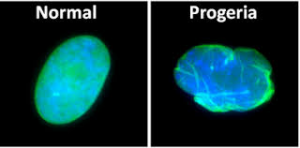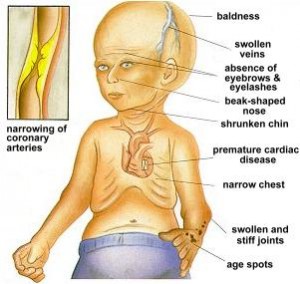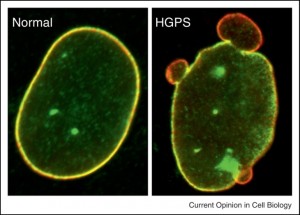Part 1 – The Life of a Genetic Mutation
Hello my name is Ria but my real name is Progeria which is a Greek name for ‘progeros’ which means prematurely aging in Greek. I live in my hostess who is name Kate. Kate is only 10 years old but has the appearance of an 80 to 90 year old women. I’m an extremely rare and fatal genetic condition. My friends have only been found in 118 other people in 2015. I am a spontaneous gene mutation that only effects a single gene. The mutation is caused by a gene named LMNA, it produces lamin A protein which helps hold nucleus cell together. The abnormal lamin A causes the nucleus to be unstable then slowing kills the cell prematurely which causes the hostess to being the process of premature aging and me, Progeria! I can also cause atherosclerosis which cause the arteries to become severely hard and stiff I make Kate have very specific physical traits like a big forehead, large eyes, and hair loss on head, eyelashes and eyebrows. I also cause Kate to have a high-pitched voice, a loss of body and muscle mass which makes her very weak. Her veins are very visible as well as her slow and abnormal tooth growth. Kate gets bullied a lot of looking the way she does. Unfortunately for Kate her average lifespan is to 14 years old, that means Kate only has 4 years to enjoy life or for scientists to find a cure. Of course they are trying experimental drugs and surgeries to find the cure or something the increases the lifespan for people like Kate. The thing that makes me very rare is that I’m not in heritable so I can infect anyone. Even through all of these horrible things I do I cannot get to her mind. Kate is very smart and courageous, she enjoys life like it will be her last and that’s something I really love about Kate.
There are some pictures of me!
http://www.istem.eu/en/biotherapies/progeria-project/
http://ashlandscience.shoutwiki.com/wiki/Progeria
http://www.intechopen.com/books/genetic-disorders/hutchinson-gilford-progeria-syndrome
Part 2 – The Making of the Mutation Story
What is Progeria? (http://www.medicalnewstoday.com/articles/146746.php)
Progeria is extremely rare and fatal genetic condition. Also known as HGPS (Hutchinson-Gilford Progeria Syndrome). The word comes from the Greek word progeros which means “prematurely old”. Progeria cause children to appear much old compared to other children (The affects cause you to have the appearance of accelerated aging). The cells die prematurely, giving the effect of looking older than they really are.
What causes Progeria? (http://www.progeriaresearch.org/progeria_101.html)
Caused by mutation is gene called ‘LMNA’ (lamin-a). LMNA gene produces lamin A protein which is the structural scaffolding that holds the nucleus cell together. The abnormal lamin A causes progerin (PROGERIA) which makes the nucleus unstable that instability causes the process of premature aging and the mutation Progeria.
What are the physical traits from Progeria? (http://www.webmd.com/children/guide/progeria)
The physical traits of Progeria are:
- A bigger head
- Large eyes
- A small lower jaw
- A thin nose with a “beaked” tip
- Ears that stick out
- Veins you can see
- Slow and abnormal tooth growth
- A high-pitched voice
- Loss of body fat and muscle
- Hair loss, including eyelashes and eyebrows
Interesting facts about Progeria? (http://healthresearchfunding.org/7-interesting-facts-progeria/)
Only 118 children have been identified as having progeria as of 2015. Makes children look 80 to 90 years old and the average lifespan is 14 years old. It doesn’t affect the mind: Changes are present in the physical bodies but the mind is not effect (the kids are very smart, courageous and full of life). It’s not hereditary is a spontaneous mutation of a single gene. There is a big risk of heart disease – can develop atherosclerosis (the severe hardening of the arteries it begin at early childhood)


